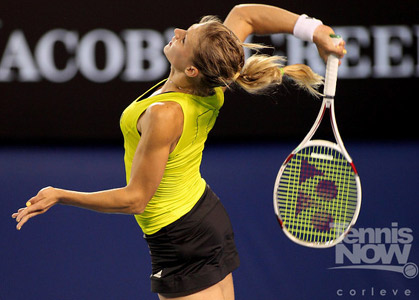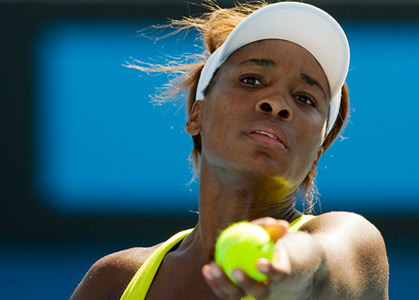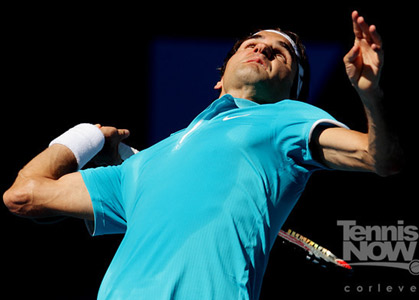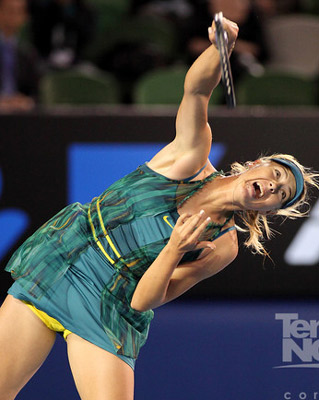9D3CAF20-B2D6-4BA7-8D12-5DC47947D832

By Kent Oswald
© Mark Peterson/Corleve
(August 24, 2010) In his first inaugural address, March 4, 1933, President Franklin Roosevelt, cousin of Tennis Hall of Famer Ellen Crosby Roosevelt, offered those who step up to the baseline the best coaching advice anyone will ever receive: "The only thing [you] have to fear is fear itself."
Concern to actual cowardice can strike anyone and at any time from the feeblest hacker upward. Pete Sampras ended years 1993 to 1998 as World No 1. His legacy of 14 major singles titles (64 titles overall) and career win-loss record of 762-222 was built on a dominating first serve and intimidating second. ("You're only as good as your second serve," offers Darren Cahill, coach, commentator and former top-25 player.)
For Sampras, the serve is a survival skill.
"You kind of live and die by the serve," said Sampras after falling to Richard Krajicek 6-7(2), 6-4, 7-6(5) in the 1998 Eurocard Open. He hit but 55 percent of his first serves (often referred to as one of The Greatest Shots in Tennis History into the box and double faulted up 3-2 in the third-set tiebreak. "I think I just got a touch tight and I paid the price," he explained.

Venus Williams owns the acknowledged record for the fastest serve in women's tennis history — WTA rules stipulate a serve must be recorded on stadium court and must be in play to count — a 129 mph missile she struck at both the 2007 US Open and 2008 Wimbledon. Venus says she steps up to the line trying to orchestrate three elements — her mood, technique and tactics — in concert leading to point of contact.
"When I step up to the line I really just kind of go through how I want to play the point and set the point up and just come to the line with a plan I want to execute," Williams told Tennis Now today. "You gotta have the technique to make the shot so that when the pressure comes you know you have the technique to make it.That's when the technique really counts — under pressure."
From the moments between cradling the fuzzy yellow ball until he or she tosses it skyward, the server is in complete control of the game. The ball bouncing, bend, toss, torso uncoil, arm acceleration, wrist snap and contact can make him or her invincible. However, it can also make him or her act crazy. For proof, consider the 2009 U.S. Open women's semifinal.
Serena Williams' match-ending tirade loss to Kim Clijsters over a foot fault arrived in the wake an overall serving meltdown. She was squeaking in barely 55 percent of her first serves — having not been under 60 percent for five previous rounds. Her winning percentage on first serves was at 71, when she had won no fewer than 76 percent previously; and her serve was wobbly enough to garner but 32 percent of her second serve points (the most intimidating on the women's tour) versus her previous success of not less than 54 percent. Much credit has to go to former U.S. Open champ Clijsters, but in a match most observers expected to be the stepping stone to repeating her 2008 Open triumph, the usually unflappable Williams, not coincidentally also the most dominating server on the women's tour, was fighting herself every time she stepped up to the baseline.
The cause of this deconstruction of even the greatest of swings is a mystery. "Of all the strokes," says former U.S. No. 4, psychologist Allen Fox, the serve is the most problematically psychological of the bunch ... the most prone to the yips."
Fox, formerly coach at Pepperdine, author of books, including "The Winner's Mind," and currently coach of various tour players says that apparently from nowhere the fear cycle takes over: "…people get scared to hit their serve. ... A guy on [on his college team] developed yips on his serve. He got to the point where he would double fault four times in a row. His hand would get stiff and he would put so much spin on that ball that it wouldn't reach the net.
"When you get the 'Oh my God, what's wrong' thought, you start to do some very bad things," says Fox.
Wimbledon, 1993. Jana Novotna, No. 9 in the world and having outserved Martina Navratilova, is up a set, a double break and a score of 4-1 in the final against Steffi Graf. She has won 8 of the last 10 games. She double faults holding game point; loses that game and the next. From 30-30 at 4-3 she whacks three doubles faults in four points. Two games later Graf is again champ and Novotna is historically frozen in the headlights of tennis history, bursting into tears on the Duchess of Kent's shoulder.
"It's hard to make [a serve] 100 percent 'yip-proof','" adds Pam Shriver. U.S. Open finalist at age 16, Shriver reached No. 3 in the world, and racked up 21 single and 106 doubles titles, including a career grand slam four times over. "I started to have trouble [after eight or nine years] controlling my toss and it created an overall anxiety that was viral in nature in how it affected my entire serve [and game]."
Fear can inhibit the serve and stunt the server's potential growth.
"Most people never become the best they can become because they're afraid of failure,"says Bradenton sage Nick Bolletieri. He faults the parents and coaches who focus a youngster's serve on just putting it into play and implanting a mentality of not taking chances: "Champions don't wait for opponents to give them the match. ... You can't do in crunch time what you probably haven't done during training."

Of course, you can train for crunch time. Cahill recommends that when you do start to tighten up (as everyone inevitably does), consider adjusting your grip easternward to impart more spin on the first serve and then just focus on hitting it in — not as hard as you can — just in and angled from the receiver. When he works with someone whose serve is getting the better of his or her head he'll look to see if it is possible to lower the toss and simplify the serving motion.
According to Vic Braden, "the serve is the most misunderstood stroke in tennis." Students at his tennis colleges are often stunned at how easy it is to hit 30 miles per hour faster (with less effort) using a lower toss and more efficient energy transfer from their stance and through ball contact. Too many player go for "the trophy look" (arms wide apart, eyes locked into the ball tossed sky high), arm muscles contracted and motion stopped with the ball not far enough in front, all while letting the mind wander.
Former World No. 17 Chip Hooper stands nearly 6-foot-6 and owned a mammoth serve in his playing days. At the 1982 US Open, Hooper and outgunned fellow seismic server Roscoe Tanner 6-7, 7-6, 4-6, 7-5, 7-6 in a memorable shootout and says coaches can complicate the serve too much for players.
"Serving is throwing. Look at quarterbacks in football. You see the guys squatting down to receive the ball from the center and then they take the ball right to the ear so why wouldn’t one do that in tennis?" says Hooper, who is now a coach. "Look at baseball. Of the position players the only ones who really wind up to throw are the outfielders. But of all the position players who has the strongest arm on the field? The catcher. What does the catcher do? The catcher takes the ball right from the ear and snaps the throw. Serving is throwing. There is really no argument anyway you look at it. But people do these things because tennis tends to be stubborn and sometimes resistant to change — that’s all — and it is hurting the performance of the players and the entertainment value of the game."
Of course, for every opinion in tennis, such as recommending a lower ball toss, there is a counter-claim. "What's important for me is a high ball toss," says Taylor Dent. The mantra for the explosive serve and volleyer as he steps up to the line includes a focus on being mentally tough and hitting his location and letting the repetitions from the practice court do the rest: "I've hit more serves over my lifetime than 99 percent of the population," and thus more than most he has the proof that practice doesn’t always make perfect. "As with any shot, 90 percent is just confidence," says Dent, who developed his weapon under the direction of former top 20 Aussie and one of the best serve coaches in the game, father Phil Dent. "If you're feeling great about your serve, you're probably going to serve well."
The serve is the one stroke that a player cannot hide. You can run around your backhand, but you can't get around serving struggles. Former No. 1 players including Dinara Safina, Ana Ivanovic and Maria Sharapova have gone through periods plagued by double faults, erratic tosses and a lack of confidence in the serve.

Even one of the most imposing servers in history, Andy Roddick, struggled to serve out successive matches in Cincinnati last week. Roddick failed to serve out the quarterfinals against Novak Djokovic the first time (he made good on his second chance) and could not close on serve against Mardy Fish in Saturday's semifinals losing a gut-wrenching match he had on his racquet and prompting his former coach, ESPN analyst Brad Gilbert, to remark "I'll bet that's the first time in his career Andy failed to serve out a match twice in a row."
Interestingly enough, just as the fear that destroys serves can come at any time, so can that "great feeling" Dent describes. Perhaps the most famous single serve ever came with the server cramping and having lost the first two sets of five while facing the World No. 1. Having hit 65 mph first serves, 17-year-old Michael Chang had what he would later describe as "a spur of the moment" inspiration in the 1989 round of 16 at Roland Garros. At 15-30, 4-3 he hit an underhand first serve unnerving three-time champ Ivan Lendl enough to enfeeble his return and lead to the Czech’s next-game, match-ending double fault. (To be fair in reporting on underhanded “success,” after Martina Hingis hit her second underhand serve in the 1999 Roland Garros final against Steffi Graf she fled the court under a torrent of verbal abuse from the French fans. She returned to double fault at match point, slinking off court in tears and leaving it forever the major lacking from a career slam.)
Of course, even the dominating server still have a few things to fear. Doubt it? Ask Ivo Karlovic, who hit a record 78 aces in his 2009 Davis Cup semifinal match against Radek Stepanek, but still lost in five sets and nearly six hours.
"The game of tennis is the game of momentums, up and down," says Pancho Segura. However, "...if you love tennis, the serve [and return] is the most likeable part of the game." Segura, a child of Ecuadorean poverty who grew to be a Hall of Fame player argues that the key to winning stays in the mind and begins when you hold the ball in your hand: "You just have to concentrate on getting the first serve in ... you have to attack [because] who makes the first shot tougher has the advantage."
And toughness comes from driving the fear from your mind as far as you can. Segura boils down 60+ years of experience at the highest levels of tennis to a game of the mind: "The one who knows [s]he is the winner is the winner ...," which is surely what President Roosevelt had in mind as well when he recommended a whole nation serve without fear.
Kent Oswald is the producer of the Jock Book Review, the former editor of Tennis Week and a long-time tennis journalist. He lives in New York. His previous features for Tennis Now are: Coming Of Age: Denis Kudla Has Eye On Pro Prize; Review: Patrick McEnroe's Hardcourt Confidential; Roger Federer As Philosophical Force And other Tennis Tenets; and Rapp On SAP: Behind The Scenes In San Jose.